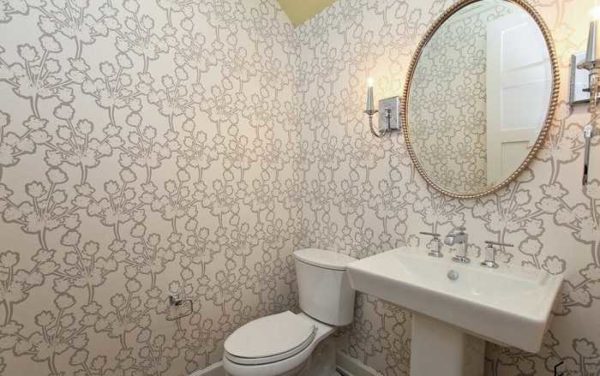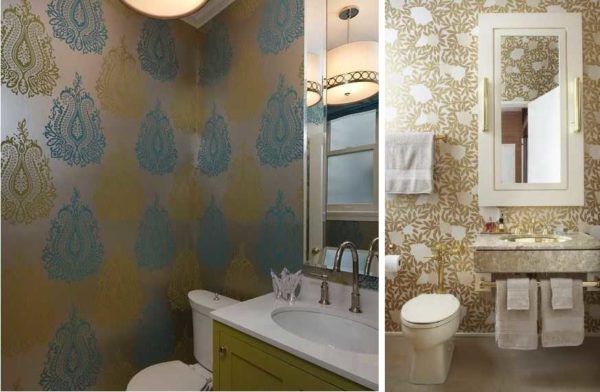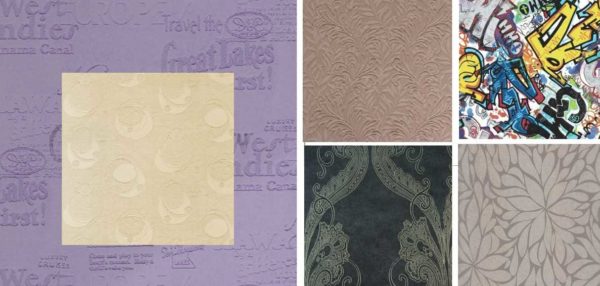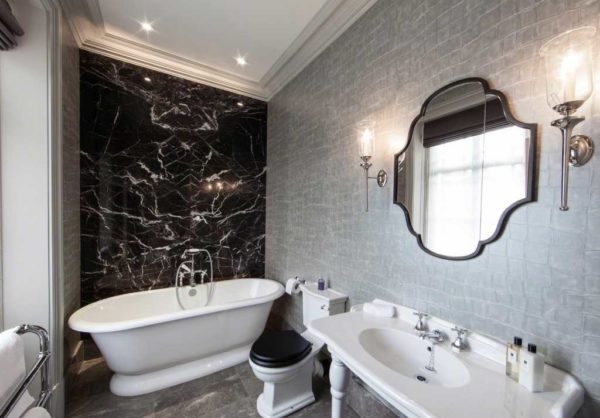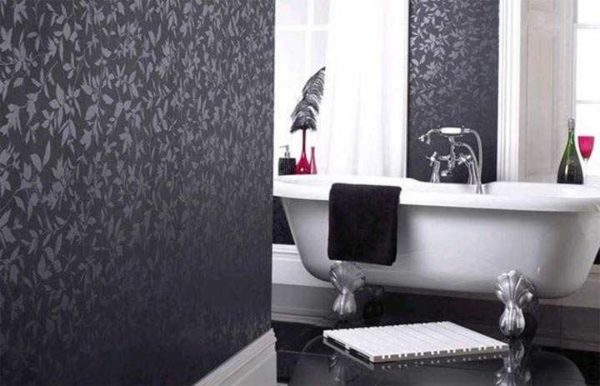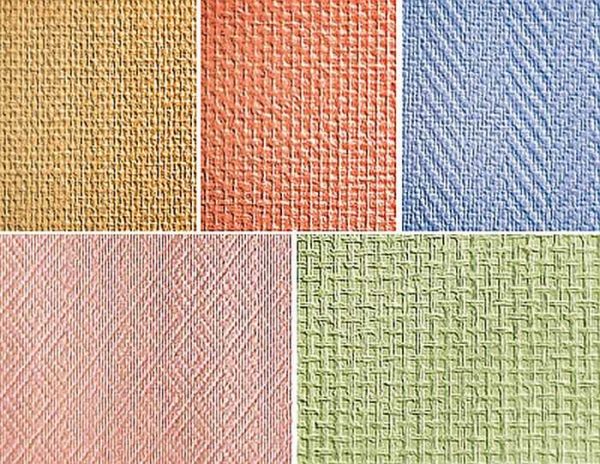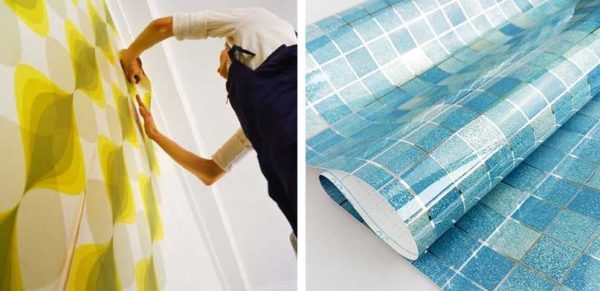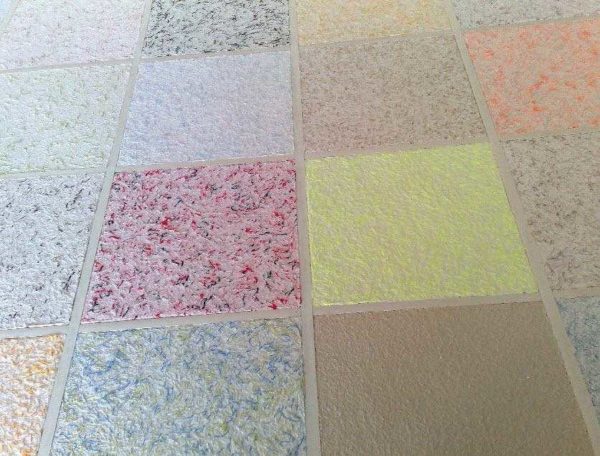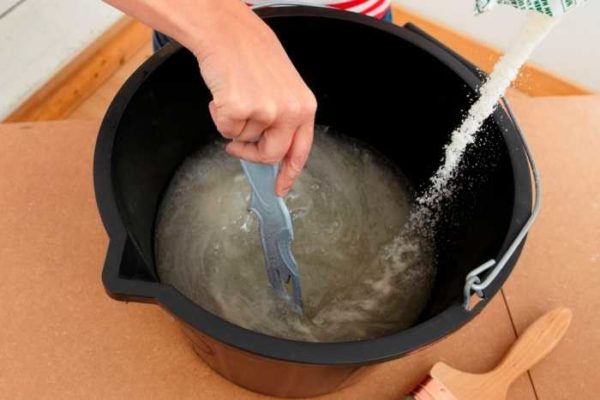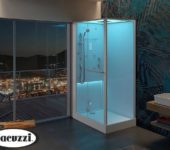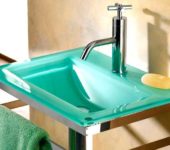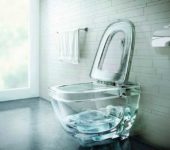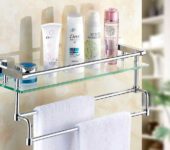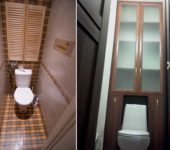What wallpaper can be glued in the bathroom
Renovating a bathroom is not a cheap pleasure, but there are finishing materials that allow you to put the room in order quickly, while spending a small amount. For example, the walls can be decorated with wallpaper. What wallpaper for the bathroom can be used - in the article.
The content of the article
Wallpaper in the bathroom - pros and cons
It is still believed that ceramic tiles are the best option in the bathroom. But this method of finishing requires significant funds, a large amount of work. Therefore, the minimum period for which such a finish is designed is 10 years. It happens that the tiles do not change for 20 years or more. Not everyone is happy with this stability. The fashion for decoration and finishing materials is changing rapidly, and we all want our home to be stylish and beautiful.
In addition, there is another nuance that should be taken into account by the owners of apartments in new buildings: the ceramic tiles are very tough. In newly built houses, when the building shrinks, this can lead to cracks.
These reasons and the fact that the tile looks too "cold", make you think about what else besides tiles can decorate the walls in the bathroom. One of the most budget options is wallpaper for the bathroom. They cost several times cheaper than tiles (even the most expensive options), they are glued quickly. All this allows you to change the finish once a year or even more often. Tired, or the wallpaper has lost its attractiveness - replaced.
This solution also has disadvantages. First, you will have to choose special wallpapers that can feel normal in rooms with high humidity. The second - in areas of direct contact with water, the walls are usually trimmed with other materials that are more resistant to moisture. Most often, tiles are laid in these areas, and wallpaper is pasted in the rest. But there is still a way out - to protect the wallpaper with transparent glass or plastic.
To make the bathroom wallpaper last longer, it is worth gluing it with special glue. Wetroom formulations contain antibacterial additives that prevent the growth of mold and mildew.
Types of wallpaper for the bathroom
Not all wallpapers can be used in damp rooms. For example, paper or paper-based ones are not suitable for the bathroom. You can stick them on, but they will quickly lose their attractiveness; after taking a bath or hot shower, they will absorb moisture. Therefore, although paper wallpapers are inexpensive, they should not be used in the bathroom. The exception is moisture resistant washable wallpaper. But this is an economical option that is suitable, for example, for a country or garden house.
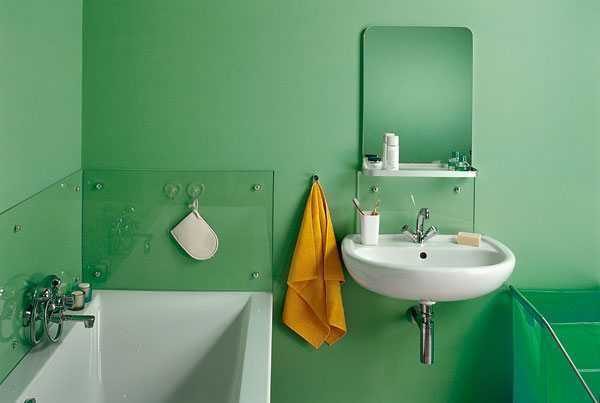
You can protect the wallpaper from direct contact with water with panels of glass or transparent plastic
Non-woven
Non-woven wallpaper is often called wallpaper with a non-woven base, on which various coatings are applied (most often vinyl or paper is applied to the non-woven). But in this case we are talking specifically about non-woven wallpaper on a non-woven basis. They are not afraid of moisture, so they can also be used in damp rooms. This type of "clothes" for walls is:
- For painting. In this case, the canvases are white, they can be repainted up to 8 times (depending on the density of the non-woven fabric).
- With pattern and color. They are not suitable for painting, but they have an interesting texture.
The advantages of such "purely non-woven" canvases are the ability of the material to pass air and steam. They say that such walls "breathe", due to which there is a natural regulation of humidity (during the workventilation systems).When looking for this kind of finishing materials, in the search box, ask "non-woven wallpaper on a non-woven base", otherwise the issue will mainly consist of vinyl wallpaper on a non-woven base, and their quality and appearance are completely different.
Non-woven wallpaper for the bathroom is glued on a flat, clean surface using a special glue with high adhesion. The glue is applied only to the walls, the canvases are rolled dry, carefully smoothed.
Flizelin itself is a rather dense material that practically does not stretch. In order to avoid problems during the gluing, the preparation of the walls should be at a high level - dry canvases do not stretch and do not "shrink", so it is difficult to hide the flaws. And this is one of the disadvantages.
Vinyl
For the bathroom, non-woven vinyl wallpaper is suitable. Vinyl is also produced on a paper basis, but this option is not suitable for wet rooms, since the paper is hygroscopic and usually such a finish quickly lags behind the walls.
Vinyl wallpaper is a thin film of polyvinyl chloride applied to a non-woven base. Vinyl film is tenths of a millimeter thick, but it is so strong and dense, but it is quite difficult to damage it, so you can even wash it with a brush and detergents. In addition, it does not allow moisture to pass through in any form. On the one hand, this is good - moisture does not penetrate the walls. On the other hand, not very well, because ventilation in the bathroom should work very well, since the atmosphere cannot naturally return to normal. If you decide to use vinyl wallpaper for your bathroom, it is advisable to install exhaust fanto provide forced regulation of humidity.
Vinyl wallpaper for the bathroom can be of several types - vinyl can be applied in several ways. There is thin vinyl, the walls must be prepared carefully for it, since all the irregularities will be visible. Especially if the color is light and the texture is smooth. There is a denser and thicker vinyl, which better hides surface imperfections, there is foam vinyl, which, due to the textured surface, can hide imperfections. The surface preparation in this case may not be so perfect. But, regardless of the thickness of the film, large irregularities are unacceptable, since the non-woven base does not stretch well.
Vinyl wallpaper is glued in the same way as non-woven wallpaper: the wall is coated with glue, and the canvases themselves are glued dry. But the glue is used differently, with an even higher adhesive ability, since the weight of one roll is even greater (due to the weight of the PVC film).
Glass fiber
If you like painted bathroom walls, you can use paintable glass wallpaper. They are a fabric woven of fiberglass, which are intertwined in a special way, due to which a pattern is formed. The assortment of drawings is not so great, but due to the fact that these canvases can be repainted up to 20-30 times, you can quickly change bathroom design.
Fiberglass wallpaper for the bathroom has a long service life, is not afraid of moisture, is breathable, does not rot, is made from natural raw materials, does not support combustion. The canvases have a certain texture, due to which they can be glued to imperfect walls. In general, not a bad option. There are few disadvantages. First, they cost more than the same vinyl wallpaper. But they can be repainted, which allows you to quickly change the boring style. The second minus is that it is difficult to glue them. You have to take care not to "level" the relief, to use special glue. The third drawback is that you still need to buy paint and several times paint glass wallpaper - to obtain an even color. This also raises the cost of this type of finish.
Self-adhesive wallpaper
There are self-adhesive tapes in stores that can be used in the bathroom. It is glued on a flat, clean base. In this case, the preparation of the walls should be ideal: the film is very thin and it cannot hide any flaws, but only emphasizes all the irregularities. The properties of this finishing material are determined by the properties of vinyl: the film is strong, dense, does not allow water, steam, and air to pass through. Walls covered with this material can be cleaned with a brush and non-abrasive detergents. PVC does not allow water to pass in any form, and a well-functioning ventilation is required to remove high humidity.
Self-adhesive for the bathroom can be matte or glossy. On the glossy one, traces of water and soap are more visible, but it is easier to care for it: all dirt is easily removed from a smooth surface. On a matte film, deposits are less visible, but due to the porosity of the surface, they are more difficult to remove. Another nuance: the glossy surface, due to the reflection of light, makes a small room visually more spacious. But in bright light, a lot of glare affects the eyes. They get tired faster.
Before gluing, the surface must be cleaned of dust, degreased. Then cut the film into strips of the required length. Gradually peeling off the protective substrate, glue the PVC film, expelling the air from under the film with a plastic spatula.
Liquid wallpaper
Another very interesting option for decorating walls in the bathroom is liquid wallpaper. By the nature of the application, this material is more like plaster, since in its finished form it is a pasty mass that is applied to the walls using spatulas or similar tools. The main advantage of this type of finishing materials is the undemandingness of the base. Since the layer can be up to 1 cm, even rather large irregularities can be leveled. But, since the composition cannot be called cheap, many prefer to carry out preliminary leveling with cheaper mixtures (leveling plaster or putty), and the final leveling is already with the help of liquid wallpaper.
Liquid wallpaper is sold in the form of a dry powder, which is diluted with water in certain proportions, or in the form of a ready-to-use paste. The composition includes cellulose fibers, mineral components, textile fibers, coloring pigments. All this is mixed with an astringent component (glue), diluted with water. The resulting paste is applied to the walls.
Adhesive selection
In order for the wallpaper for the bathroom to hold well, so that mold and fungi do not start on them, it is necessary to select the right glue. It is chosen depending on the type of wallpaper: for vinyl - its own composition, for non-woven - its own. But at the same time it is necessary to ensure that bactericidal additives are included in the glue.
For greater reliability, it is advisable to treat the prepared surface with a primer that has a bactericidal effect. In addition to the fact that the primer prevents the development of harmful microorganisms, it evens out the absorbency of the walls, reducing the consumption of glue, and prevents the formation of bubbles.

